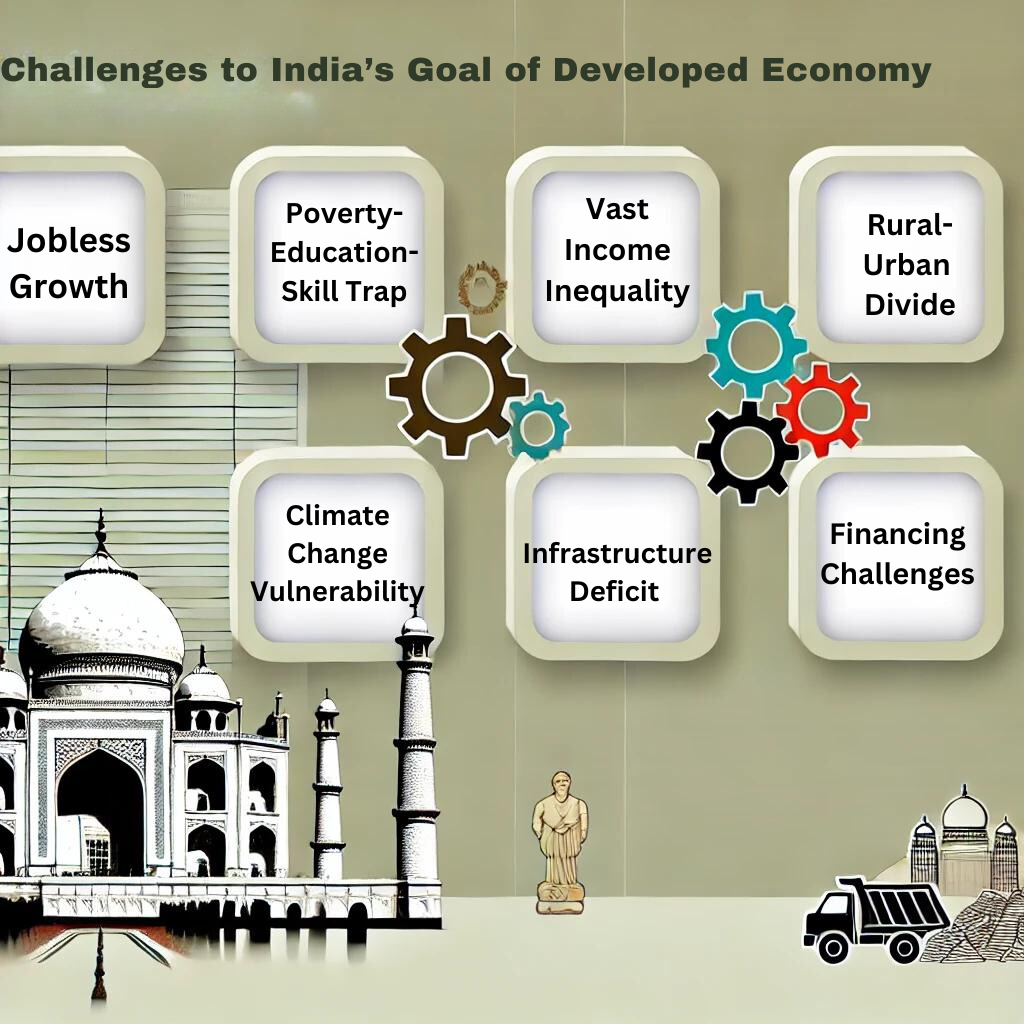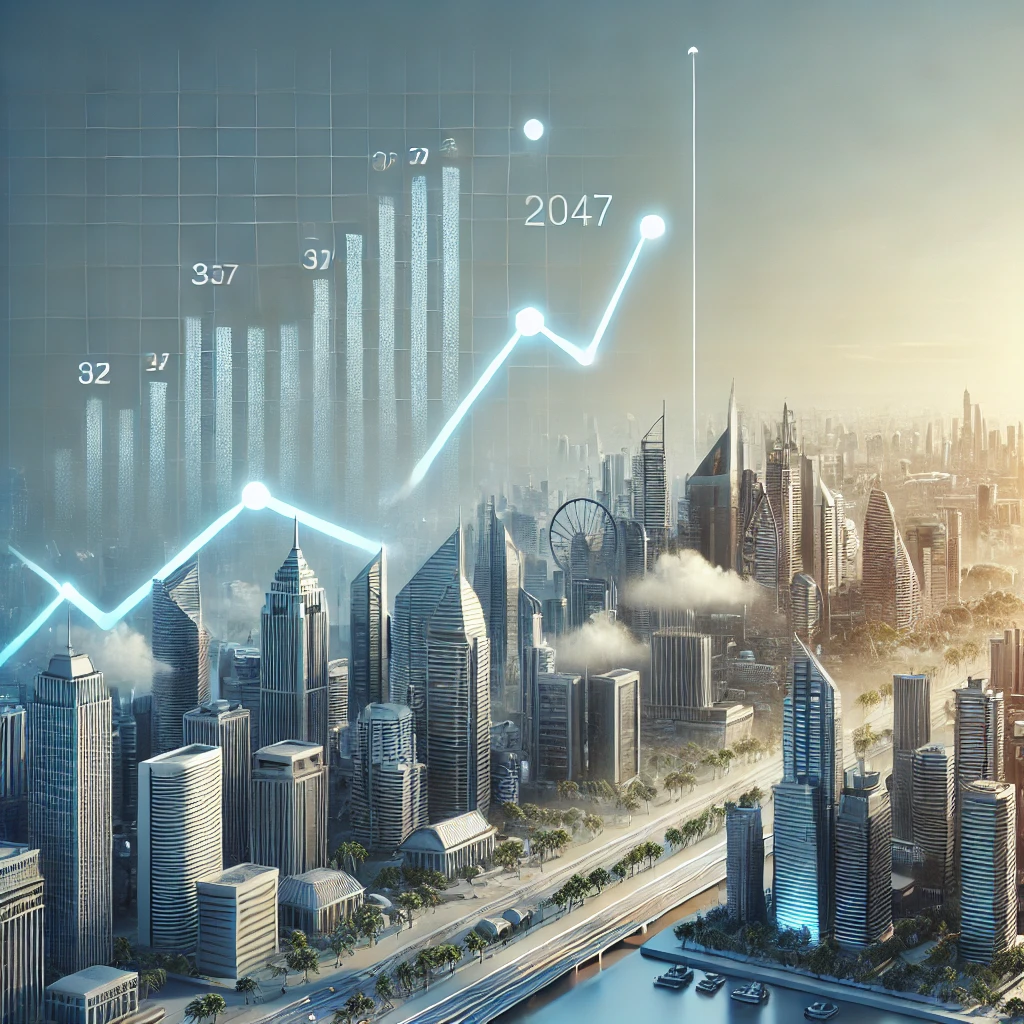India is on a path of rapid economic growth, aiming to achieve developed economy country status by 2047, the 100th year of its independence. However, this goal requires a significant increase in per capita income from USD 2,600 to USD 10,205. This ambitious target translates to a per capita income growth rate of 7.5% and an overall GDP growth rate of 9% per year. Achieving this will not be easy, requiring job creation for the millions entering the workforce each year. India’s journey to becoming a developed nation involves a comprehensive and multifaceted approach.
Origin of the Article
This editorial is based on ‘India’s Transition to a Developed Economy’ published in Hindustan Times on June 18, 2024. The article discusses India’s economic growth and its challenges in becoming a developed economy by 2047.
Relevancy for UPSC Students
Understanding India’s economic growth and associated challenges is crucial for UPSC aspirants. This topic is relevant to GS Paper 3, covering Growth and development and Government Policies. It helps aspirants grasp economic concepts, policy impacts, and development strategies, enhancing their analytical skills for the examination.

Why in News
India’s aspiration to become a developed economy by 2047 has garnered significant attention, making it an essential topic for UPSC aspirants. This ambitious goal involves increasing per capita income to USD 10,205 and achieving a GDP growth rate of 9% annually. The challenges and strategies discussed resonate with previously asked UPSC questions on economic growth, government policies, and inclusive development, providing a comprehensive understanding of India’s economic trajectory.
Factors Propelling India towards a Developed Economy
India’s journey towards becoming a developed economy is propelled by multiple factors that collectively enhance its growth trajectory. Each of these factors has a significant impact on the nation’s economic, social, and infrastructural development, setting the stage for sustainable progress.
Rise of the Services Sector
The services industry in India is experiencing rapid expansion, contributing more than 50% to the country’s GDP. This sector is a major source of high-paying jobs and attracts substantial foreign investment, playing a pivotal role in driving economic growth.
Demographic Dividend
With a median age of 28.2 years, India’s young and growing population presents a significant opportunity for economic advancement. Properly training and utilizing this human capital can lead to substantial economic growth, as a skilled workforce drives innovation and productivity.
Government Initiatives for Infrastructure Development
The Indian government is actively investing in infrastructure development through projects like the Pradhan Mantri Gati Shakti National Master Plan. These initiatives aim to enhance efficiency and stimulate economic activity across various sectors, providing a robust foundation for sustained growth.
Digital Transformation and Startup Ecosystem
India’s digital transformation, accelerated by the Digital India Initiative and increased internet penetration, is fostering a vibrant startup ecosystem. The widespread adoption of the Unified Payment Interface has further bolstered economic activities, positioning India as a hub for technological innovation.
Economic Resilience Despite Global Slowdown
India has shown remarkable economic resilience amidst global uncertainties such as the Russia-Ukraine War and supply chain disruptions. Despite these challenges, domestic demand has remained robust, enabling the country to sustain growth and stability in a turbulent global environment.
Innovation and Entrepreneurship
India’s culture of innovation and entrepreneurship is thriving, with over 112,718 DPIIT-recognized startups spread across 763 districts. This growth is supported by research institutions and global collaborations, driving technological advancements and positioning India as a leader in various fields.
Challenges to India’s Goal of Developed Economy
While India has made significant strides, the path to becoming a developed economy is fraught with challenges. These complexities require multifaceted solutions to ensure sustainable and inclusive growth.

Jobless Growth
Despite a commendable economic growth rate of 7.8% in 2023-24, job creation has not kept pace. A significant portion of the workforce remains in low-productivity agriculture, which contributes only 15% to GDP but employs 44% of the workforce, highlighting the need for more inclusive growth.
Poverty-Education-Skill Trap
The quality of primary and secondary education in India is often subpar, impacting cognitive development and resulting in a skilled workforce deficit. With 150 million fewer skilled workers, the potential benefits of higher education and economic growth are diminished.
Vast Income Inequality
Income inequality in India is stark, with the wealthiest 1% earning 22.6% of the national income in 2022–23. This disparity hinders inclusive growth and restricts access to basic services for a significant portion of the population, impeding overall progress.
Rural-Urban Divide and Unbalanced Development
Economic progress in urban areas contrasts sharply with the poverty and lack of infrastructure in rural regions. Bridging this rural-urban divide is crucial for social cohesion and balanced development, ensuring that growth benefits all sections of society.
Climate Change Vulnerabilities
Rapid industrialization and urbanization have led to environmental degradation, including pollution and biodiversity loss. These challenges not only affect public health but also threaten the sustainability of economic growth, necessitating urgent attention to environmental issues.
Infrastructure Deficit and Financing Challenges
India faces a significant infrastructure deficit, particularly in transportation, power, and urban development. Addressing this shortfall, estimated at USD 1.5 trillion by the World Bank, requires innovative financing solutions and substantial investment.
Measures to Accelerate Progression towards Developed Economy
To fast-track its journey to developed-nation status, India must implement strategic measures and policy initiatives that address both current challenges and future opportunities.
Leveraging the Demographic Dividend through Skill Development
Investing in vocational education, skill development programs, and apprenticeships is essential to creating a globally competitive and employable workforce. These initiatives can harness the potential of India’s young population, driving economic growth.
Balanced Regional Development and Rural Transformation
Investing in rural infrastructure, such as roads, electrification, healthcare, and digital connectivity, is vital for bridging the rural-urban gap. Encouraging agro-processing facilities and manufacturing hubs in rural areas can create non-farm job opportunities, fostering balanced development.
Preventive and Affordable Healthcare
Enhancing public healthcare spending to at least 2.5% of GDP, as outlined in the National Health Policy 2017, is crucial for improving the Human Development Index. A robust public healthcare system ensures a healthy population, which is vital for sustained economic growth.
Innovative Infrastructure Financing and Public-Private Partnerships
Exploring novel financing models, such as asset monetization and infrastructure securitization, can address the infrastructure deficit. Promoting infrastructure investment trusts (InvITs) and real estate investment trusts (REITs) can attract long-term investors, freeing up funds for critical projects.
Fostering Innovation and Technological Advancement
Increasing investment in research and development to at least 2% of GDP, as proposed by the Science, Technology, and Innovation Policy 2020, is essential. Establishing clean technology parks, incubation centers, and circular economy zones can attract global technology leaders and foster innovation.
Formalizing Informals and Startup Hubs Beyond Metros
Implementing a portable social security system for informal sector workers can incentivize formalization. Additionally, creating startup hubs outside metropolitan areas can diversify economic growth and promote regional development.
Green Collar Jobs Revolution
Training programs in renewable energy, waste management, and sustainable infrastructure can equip the workforce with skills for green jobs. This transition not only addresses environmental challenges but also creates new economic opportunities.

Way Forward
India must prioritize inclusive growth and innovation to achieve the ambitious target of becoming a developed nation by 2047. This entails investing in skill development to harness the demographic dividend, fostering rural transformation, and ensuring affordable healthcare. Embracing novel infrastructure financing, nurturing technological advancement, and promoting green jobs are crucial. By formalizing the informal sector and extending development beyond metros, India can ensure balanced growth and resilience against global economic shifts, paving the way for a prosperous future.
Conclusion
The journey to transform India into a developed economy by 2047 is a formidable yet achievable goal. It requires a blend of inclusive growth, innovation, and strategic investments in human capital and infrastructure. By addressing the challenges and leveraging the opportunities, India can pave the way for a prosperous and equitable future. Aspiring civil servants have a pivotal role in steering this transformation, underscoring the importance of visionary and effective governance.
PESTEL Analysis
| Political: India’s political environment is pivotal in driving initiatives such as the Pradhan Mantri Gati Shakti National Master Plan and Digital India Initiative. These governmental policies support infrastructure and digital revolution, key elements in the country’s development agenda. Political stability and effective governance are crucial to maintaining the growth trajectory and implementing economic reforms. Economic: India requires a robust annual GDP growth rate of 9% and a per capita income growth of 7.5% to reach its goal of becoming a developed nation by 2047. While the services sector and foreign investment play critical roles, challenges like jobless growth and significant income inequality pose threats to sustainable economic development. Addressing these through inclusive growth strategies and innovation in financing will be essential. Social: A young population offers a demographic dividend that can propel economic growth if leveraged through adequate education and skill development. However, educational deficits and the rural-urban divide are significant hurdles. Programs aimed at vocational training, rural infrastructure improvement, and formalizing informal sectors can help mitigate these challenges. Technological: The rise of digital platforms and a burgeoning startup ecosystem highlight India’s technological advancement. Continued investment in R&D and fostering a culture of innovation are vital for sustaining technological momentum and driving economic growth. Environmental: Industrial activities contributing to pollution and deforestation are pressing concerns. Sustainable practices and green job creation in renewable energy sectors are necessary to ensure environmental sustainability aligns with economic goals. Legal: Regulatory frameworks supporting innovative infrastructure financing, skill development, and healthcare improvements are required. Legal reforms to formalize the informal sector and implement a portable social security system will support the workforce and contribute to economic resilience. |
| UPSC Civil Services Examination, Previous Year Questions (PYQs) Mains Q. Discuss how India has demonstrated economic resilience amidst global challenges such as the Russia-Ukraine war and supply chain disruptions. What measures can further strengthen this resilience? Q. Discuss the importance of increasing R&D investment to at least 2% of GDP for India’s development. How can innovation hubs attract global technology leaders and drive economic progress? |


